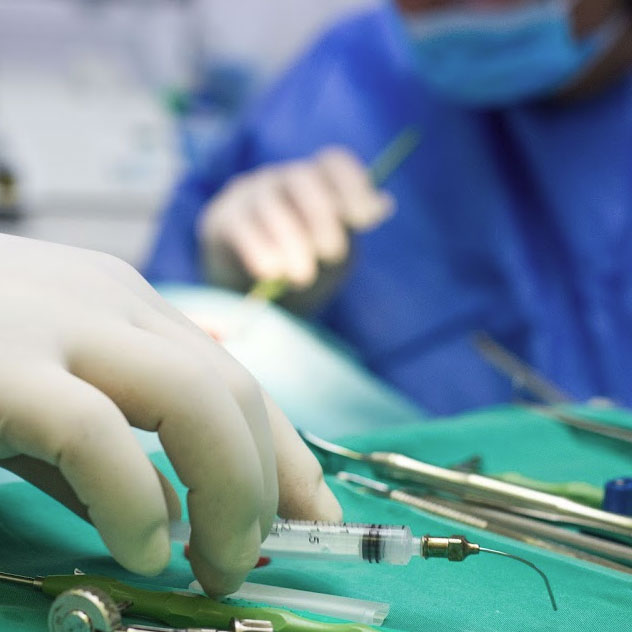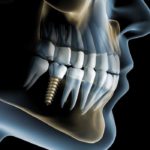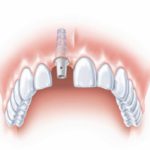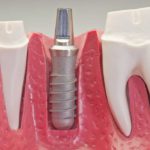The professional surgery team offers you the insertion of the implants and the making of the prosthetics’ products on them – the individual crowns, dental bridges, mobile dentures … At inserting the implants we use the topmost implantologic systems Astra tech and Bredent.
An implant is actually a quite simple metal screw, formed in a way that it is as best fitted in the bone and it serves as an artificial root for an individual tooth or as a dental support, partial mobile or complete mobile denture. The implants are made of the medicine titanium or titanium alloys. A dentist receives the sterile packed implants and as such he inserts them into the small holes in the bone, which are prepared as a part of the implant procedure. Then a period of an osteointegration – growing into the bone follows, which might take from 3 to 6 months. After this period an implant is fixed and as such can be burdened. However, nowadays there is a tendency to burden the implant right after the insertion itself.
Actually, anyone who wishes to substitute the missing teeth. There are however the relative restrictions at some systematic diseases, for example at diabetes, and strong smoking is also undesired. There should also be enough bone on the spot of the missing tooth, which enables the suitable anchorage of the implant. The implants are most commonly used with people who have lost all their teeth and the implants therefore serve as the anchorage for fixing the total mobile denture or for the total fixed dental bridge. The implants are also convenient for substituting either the single missing tooth or more teeth.
 In the presented pictures it is easy to imagine what the implants really substitute. The first picture is the so called “orthopan” (orthopantomogram), which presents the rarely seen state of teeth at the 55-year old person. All the roots are there and each of them carries the dental crown.
In the presented pictures it is easy to imagine what the implants really substitute. The first picture is the so called “orthopan” (orthopantomogram), which presents the rarely seen state of teeth at the 55-year old person. All the roots are there and each of them carries the dental crown.
The second picture presents one of the more demanding, but of extremely qualitative solutions for the patient, where the lost teeth are substituted by the dental bridge bound to implants.
These are just two extreme cases, however, there are various states, which could be solved by the implants.
The picture shows two simple cases for fixing the total denture:
- with “patent buttons”, similar as with wind jackets, except that these fixing systems are much more precise.
The success depends on the single position of the implants in the jaw and on the part the implant will substitute – what function the implant will have. The most successful are the implants in the front part of the lower jaw. Here the success is from about 98 to 100%. In the other parts of the mouth the percentage is slightly decreased – in the front part of the upper jaw is from 90 to 95%, in the back of the lower and upper jaw might be a percentage less. However, such percentage of success is one of the highest in dentistry in general. Nonetheless, the oral care is of vital importance for “survival” and success of the implants. Without it the implants will not serve as they could.
Actually, there are no many things that could go wrong. It is possible that the implant does not grow into the bone. It can also break. Sometimes there could be difficulties with linking the implants with the denture or dental bridge. An extremely rare complication might also be an inflamed reaction or inflammation of the soft tissue or bones as a consequence of the implantation. In the lower jaw there could be a nerve injury, while in the upper jaw the jaw sinus or the bottom of the nasal cavity could be injured. It is necessary to point out that all the above mentioned complications happen in less than 5% of all the treatments with implants. Nevertheless, the complications are easily improved and treated in most of the cases.
It is best to contact first your personal dentist, who will give you the exact information with the possibilities of the implantation and direct you to the proper institution – the dental centre, where the implants can be done. This could either be a general dentist, an oral surgeon, a parodontologist … The specialization in the implantology does not exist. One should be aware that the first part of the implantology is the insertion, the second is the prosthetic upgrade and both parts are inevitably linked to gain success and they demand mutual cooperation of all people included in the therapy.
Nowadays the time and the lifestyle itself dictate us to substitute and arrange the set of teeth as a part of general health. Total and partial dentures however play the functional and aesthetic role to some extent, but their stability can still be a problem. With the new material and technology development the implants have reached such a level that can fulfil all the demands regarding the stability of the prosthetic substitutes, together with the corresponding function and aesthetics.
In the lower jaw three months after the implantation and six months in the upper jaw. However, these have been the axioms for a very long time, but have been changing recently. In certain cases the implant can be burdened right away after the treatment, while in most cases the time is specified individually – from patient to patient. It is to bear in mind that better implant systems enable shorter time of burdening or even the immediate burdening.
The implantation is done in the local anaesthesia and is therefore painless. After the ease of anaesthesia in about 3 to 4 hours, a slight pain might appear which varies from patient to patient and can be easily abolished by some painkillers. A slight swelling and some bruises in the operated area might occur, lasting from 7 to 10 days. If the pain does not pass off for a longer time, the consultation with the dentist is urgent. Longer pain is not a good sign despite not always being a sign of a lack of success, but it is anyway very important to find its source. If the implant does not grow in properly or if the infection occurs, it is sometimes necessary to be removed.
In most cases this would last for about two weeks. However, it depends on the patient, the case itself and is therefore defined each time individually. It is advisable that the patient is without the denture at least for a shorter period in which the food should be softer, too. After the operation the denture does not fit well and that can even threaten the healing of the implants. In all the cases the temporary prosthetic products are ensured right after the implantation or as soon as possible.
In most cases this would last for about two weeks. However, it depends on the patient, the case itself and is therefore defined each time individually. It is advisable that the patient is without the denture at least for a shorter period in which the food should be softer, too. After the operation the denture does not fit well and that can even threaten the healing of the implants. In all the cases the temporary prosthetic products are ensured right after the implantation or as soon as possible.
Sometimes there is not enough bone on the spot of the implantation. However, this could be solved by the so called bone grafting or augmentation or water bone regeneration. It is a very common procedure and it is sometimes also used around the natural teeth. The bone, used for expansion, can be of three sorts:
- a pacient’s bone:
from other parts of the operative field (it is scratched during the operation itself), out of mouth – mostly from the hips (done by the orthopaedic surgeon).
- a cadaveric bone:
it is collected under very strict standards and supervision in the bone banks. It is a very common procedure and it has never been a case of the infectious disease with a bone from a donor. - an artificial-synthetic bone which is nowadays most frequently used.
At expansion the combinations of the above mentioned types are most commonly used. In addition, some teflon membranes can be used to “hold” the bone where we want. These procedures prolong the therapy and make it much more expensive.
The services are entirely self paid. In most of the cases the service is paid regarding the number of implants used, and additionally for the prosthetic upgrade, which is made on the implant (the individual crowns, dental bridges, total dentures, partial dentures, attached elements …). An extra paid service is also the possible bone expansion, the existing bone transformation, gum, etc. The quantity of the implants used is however more important for the success of the treatment itself rather than for the final price, therefore the price has been lately determined regarding the complexity of the entire treatment. Of course, it is more affordable if one therapist inserts the implants as well as makes out the prosthetic upgrade, which is unfortunately not always possible. In the future, when the implants will be present in the public dentist service too, they will be more affordable at the same time, too. Nonetheless, the price might vary also on the position in the jaw.
It is almost one of the most common questions – what to do if there is one or two teeth missing. It is the easiest to answer with an example: if the second tooth is missing, the first and the third tooth should be ground in order to bind the missing second. In the opposite case on the place of the missing second tooth the implant could be inserted with the binding crown which would substitute the second tooth. The price of the implant in such case is comparable to the three unit dental bridge, while at implants the grinding of the first and third tooth is not necessary. The final decision is however made on the basis of the consultation for each case individually.




